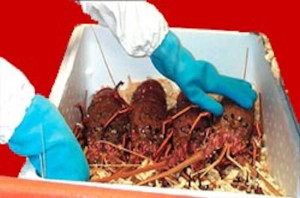
Prices have risen to about $115 per kilogram in some retail outlets, making the average cray between $75 and $85, according to reports from the Australian Broadcasting Corporation. This is an increase of around $30 per kilo on last year’s prices.
Seafood is a popular part of many Australians’ Christmas lunches and dinners.
The ABC reported that lobster exporters have said last month’s visit from China’s President Xi Jinping pushed prices up. Australian Food News reported in November 2014 that President Xi Jinping was in Australia to sign a new Free Trade Agreement between China and Australia. As part of the agreement, restrictive tariffs on a wide range of seafood, including rock lobster, abalone, and southern bluefin tuna will cease within four years.
Key lobster markets and exports
The highest overseas demand for Australian Southern Rocklobster is for live product and originates primarily from Asia. Rock lobster processed in Tasmania is exported to the mainland or directly overseas as live, fresh product, according to the Tasmanian Rock Lobster Fishermans’ Association.
The value added to the country’s regional economies involved in this industry is valued at around $1/2 billion a year, and for many small towns it is the primary source of economic activity.
Fishing is carried out in South Australia, Tasmania, Victoria and Western Australia. Export of live product has increased dramatically since the late 1980s, while exports of cooked product have declined. The estimate gross value of production (tonnes landed x average price paid to the fisher) for the 2011/12 quota year was $61 million.
In 2011-12, Australia’s rock lobster industry was valued at $384 million. Hong Kong, Japan, the United States, China and Chinese Taipei are the top export markets for Australia’s rock lobster.
Tasmania, South Australia and Victoria continue to work collaboratively through Southern Rock Lobster Ltd to market their product with the aim of expanding export opportunities beyond South East Asia. Western Australian rock lobster fisherman are represented by the Western Rock Lobster Council Inc.
Rock lobster fishing in Australia
The early 1870’s saw South Australian locals begin catching Southern Rock Lobster with hoop nets. Fishermen sold these Rock Lobster in the State’s capital, Adelaide, and Kingston in the State’s south-east, where they were expected to ask no more than two shillings a dozen off the jetty. In Tasmania the Southern Rock Lobster fishery has been contributing to the State’s fishing industry since the 1860’s.
Victoria’s commercial industry also dates back over 100 years. The introduction of beehive shaped pots early in the 20th century replaced the hoop nets previously used only in shallow coastal waters – this then lead the way for Victorian fishers to expand their operations to islands in the treacherous Bass Straight and later the East coast of Tasmania.
In South Australia the first commercial pots were used in 1899, and from the turn of the century, small industries began to emerge in different parts of the State at Kingston, on Kangaroo Island, and in the now famous fishing port of Port Lincoln – the unofficial capital of Australian Seafood.





